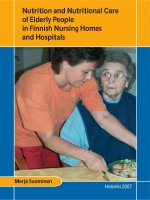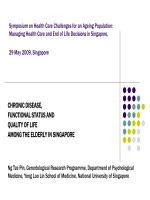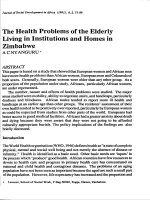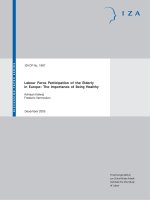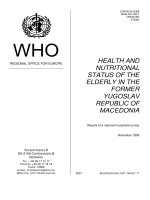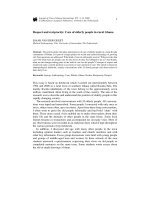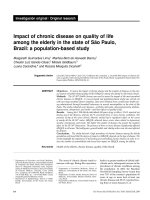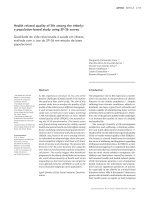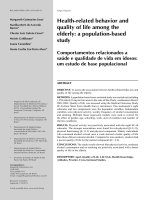Quality of Life of the Elderly People in Einme Township Irrawaddy Division, Myanmar potx
Bạn đang xem bản rút gọn của tài liệu. Xem và tải ngay bản đầy đủ của tài liệu tại đây (107.36 KB, 7 trang )
Asia Journal of Public Health, July-December 2010 Vol.1 No. 2
Asia Journal of Public Health
Journal homepage:
Original Articles
Quality of Life of the Elderly People in Einme Township
Irrawaddy Division, Myanmar
Myo Myint Naing* Sutham Nanthamongkolchai** Chokchai Munsawaengsub**
*Medical officer, Medicines Sans Frontieres-Holland ,Myanmar
**Department of Family Health, Faculty of Public Health, Mahidol University, Bangkok,Thailand
4
ARTICLE INFO
Article history :
Received July 2010
Received in revised form September 2010
Accepted October 2010
Available online January 2011
Keywords:
Quality of life
Elderly people
Self-esteem
Family relationship
Corresponding Author:
Nanthamongkolchai S,
Department of Family Health,
Faculty of Public Health,
Mahidol University,
Bangkok 10400,Thailand.
Email :
Asia J Public Health 2010; 1(2):4-10
ABSTRACT
Objective: To study the quality of life of the elderly people in Einme
Township, Irrawaddy Division, Myanmar, and factors related.
Materials and Methods: A cross-sectional survey was conducted
among 209 elderly aged 60 and over, who lived in Einme Township,
Irrawaddy Division, Myanmar. Data were collected by using structured
interview questionnaire from February 1 to 21, 2010. Statistics used for
data analysis were frequency, percentage, mean, standard deviation,
Pearson product moment correlation coefficient, and Multiple regression
analysis. Results: The majority of the elderly people (80.9%) had a
moderate level of quality of life, followed by high level(17.2%) and low
level(1.9%). The factors that were statistically significantly related to
the quality of life of elderly were education level, current illness, self-
esteem, family income, family relationship and social support. In
addition, self-esteem and family relationship could significantly predict
the quality of life of elderly by 53.3%. Self-esteem had the highest
predictive power of quality of life. Conclusion: The factors related to
quality of life of elderly people were self-esteem and family
relationship. To promote quality of life of the elderly, responsible
organizations should establish activities that enhance elderly self-esteem
and promote good family relationship.
INTRODUCTION
Quality of life is essential. Improving the
quality of life is now a common aim of
international development. However, enjoyment
in life and a sense of purpose and happiness can
still elude elderly people, making these important
problems that need to be solved, especially in
one’s advanced years
1
. It is not easy growing old
and most times, depression attacks elderly people,
and especially they tend to feel helpless and
inactive after retirement, with their role as primary
provider having finished. So, they are more
negative and sensitive and rely on others, so they
should be cared for to achieve a good quality of
life.
The quality of life of elderly people has
become relevant with the demographic shift
towards an aging society. There are indications
that concepts and concerns related to quality of
life in elderly people are different from the
general population. The majority of the elderly
people evaluate their quality of life positively on
the basis of social contacts, dependency, health,
material circumstances and social comparisons.
Asia Journal of Public Health, July-December 2010 Vol.1 No. 2
5
Adaptation and resilience might play a part in
maintaining a good quality of life. With all other
influences controlled, ageing does not influence
quality of life negatively, and a long period of
good quality of life is possible
2
. Therefore, the
maintenance and improvement of the quality of
life become important issues. The proportion of
elderly people (aged 60 or over) in the world
population
3
has increased, and also, in Asia
4
, the
size and proportion of the elderly population was
281 million and 8.2% respectively. This means
that 52% of the world’s elderly populations are
living in Asian countries. In developing countries,
including Asia, the elderly populations are
increasing rapidly. These demographic changes
are a direct result of the success of socio-
economic development that has led to a decline in
mortality rates at all ages and a reduction in
fertility. However, an aged population might be
expected to suffer with the problems of
dependency and disability leading to an increased
burden of disease. Myanmar
5
has also emerged as
a nation with an ageing population, and the
proportion of elderly people over 60 has
gradually increased from 6.4% in 1980-81 to
8.3% in 2005-06. Einme is a sub-urban area in the
Myaungmya District, Irrawaddy division. The
district is a deltaic tract, bordering south on the
sea and traversed by many tidal creeks. The
occupations of rice cultivation and fishing engage
practically all the inhabitants of the district.
According to a report from Help Age
International
6
, 2008, dependency ratio of the total
older people in delta region, was 51.8% with the
highest dependency ratio found in the poorest,
female, old-old group. Also, 6.8% of the elderly
live alone. The highest percentage of loneliness
was found in the poorest male, old-old group.
59.8% of the elderly have no means of earning a
living and 82% do not own property. 63.2% of the
elderly are classified as the poorest of the poor.
29.2% are considered poor and only 7.7% are
moderately self-sustainable. The highest
percentage of the poorest was found in the oldest
female group. Moreover, the study of the health
status and quality of life of Thai elderly by
Assantachai P and Maranetra N
7
show that 61.4 %
had a good quality of life and 38.6% had a low
quality of life. The factors associated with a low
quality of life were not living with the spouse,
poor financial status, no regular exercise, sleeping
or hearing difficulty, suffering from joint pain or
diabetes mellitus, and history of a fall within the
last 6 months. It is obvious that the elderly have
faced both physical and mental problems and
resulting bad health that led to negative mind and
lower quality of life. Thus, it is no longer possible
to ignore the commencing ageing phenomenon in
Myanmar and therefore, it is vital to anticipate the
requirements of the old age group in Myanmar in
order to plan appropriate policies to address their
growing needs and to support their quality of life.
In Myanmar, there is no specific policy for
elderly people such as compulsory welfare
services for the elderly or health insurance
coverage, and there is still low awareness of the
special needs for elderly people and staff working
in the homes for the aged who have yet to
understand the basics of care for the elderly (daily
physical activity, minor illnesses and social
support). Cooperation between health staff and
social welfare staff is still weak regarding services
at the homes for the aged
5
. So, the researcher was
interested in studying quality of life of the elderly
people in Einme Township, as well as factors
affecting the quality of life of elderly people in
Einme Township. The researcher also believes
that the results derived from the study will be
beneficial to public health sectors and other
related organizations for conducting an effective
plan and aid management to help and take care of
elderly people in future.
MATERIALS AND METHODS
The research was a cross-sectional survey on
quality of life of the elderly people with a sample
group of 209 elderly people both male and female,
aged 60 years and over. Data were collected from
February 1 to 21, 2010 by the researchers and
village health volunteers. The sample groups were
selected by simple random sampling from 6
villages of Einme Township, and were made up of
those who had been living in the selected village
at least 1 year. The research instrument was an
interview questionnaire, developed by the
researcher and consisted of 6 parts. Part 1
employed general characteristics of elderly people
such as age, sex, education level, marital status,
family type, occupation of the old aged, family
income and any chronic diseases that they had and
included 9 questions. Part 2 was to determine the
instrumental activities of daily living by using
Barthel ADL index,
8
which was used for
measuring the functional status and included 10
questions. Part 3 evaluated family relationships
and examined feeling and opinion of elderly
people towards family relations such as, love and
care, interaction among family members, respect
among family members, unity among family
members, and relaxation among family members.
The family relationships included 10 questions
and were developed by the researchers by
reviewing the family relationships in later life by
Smith
S
9
. Part 4 determined the social support by
reviewing the work of Cobb S
10
. The set of
questionnaires included 10 items relating to social
Asia Journal of Public Health, July-December 2010 Vol.1 No. 2
6
support from family and relatives or friends. Part
5 assessed self-esteem by using quick self-esteem
assessment and included 11 questions. Part 6
evaluated the quality of life by using WHOQOL-
BREF
11
assessment form to provide a quality of
life assessment that looks at domain level profiles.
It had a total of 26 questions.
This structured questionnaire was assessed for
content validity by three experts. Also, the tested
interview questionnaire was then tested for
reliability by doing a pretest in the pilot study
among 30 elderly people with similar
characteristics to those of the study population.
The results were analyzed by calculating the
Cronbach’s Alpha Coefficient of each set. The
reliability results were as follows: questionnaire
for family relationship was 0.88, social support
was 0.78, self-esteem was 0.88, and quality of life
was 0.97. The data were analyzed by descriptive
statistics in terms of frequency, percentage, mean,
standard deviation and applied to show the general
characteristics of elderly people. Chi-square test
and Pearson product moment correlation
coefficient were used to determine the factors that
were related to the quality of life of elderly people
and stepwise multiple regressions were also
applied to predict the factors that influence the
quality of life of elderly people. A p-value of less
than 0.05 was set
to consider as statistically significant.
Ethical Approval
The research proposal was approved by the
Research Ethics Committee, Faculty of Public
Health, Mahidol University, Bangkok Thailand:
Ref. No MUPH2010-027.
RESULTS
The total sample of 209 elderly people showed
that males made up 48.8% of the group and
females 51.2%. The age was between 60 and 96
years with the median age of 69 years (SD = .8.2
years). More than half of them (51.2%) were
between 60 and 69 years, followed by 35.4% who
were between 70 and 79 years and 13.4% who
were more than 80 years. The majority (70.3%)
had a primary school education and 22.5%,and
7.2% had no education, and secondary school
respectively. More than half, 55%, were married,
27.8% were single and 14.8% were divorced.
Among them, 52.6% of the respondents lived with
nuclear family members and 47.4% lived with
their extended family. About half (55.5%) had no
occupation in contrast with 44.5% who had an
occupation. There were many farmers, 40.3% of
respondents (Table 1)
.
Table1. Number and percentage of elderly
people classified by general characteristics
(n=209)
Personal characteristics
No. %
Gender
Male 102 48.8
Female 107 51.2
age (Years)
60 - 69 107 51.2
70 - 79 74 35.4
80 and above 28 13.4
Median = 69, Minimum = 60, Maximum = 96,
Mean = 69.4, S.D.=8.2
Education level
Primary school 147 70.3
None at all 47 22.5
Secondary school 15 7.2
Marital status:
Married 115 55.0
Single 58 27.8
Widowed 31 14.8
Divorced 3 1.4
Separated 2 1.0
Family type
Nuclear 110 52.6
Extended 99 47.4
Occupation of elderly people:
No occupation 116 55.5
Occupation present 93 44.5
Farmer 84 40.2
Shop 5 2.4
Carpenter 1 0.5
Merchant 1 0.5
Bus driver 1 0.5
Vender 1 0.5
Current illness
With current illness 120 57.4
Without current illness 89 42.6
Chronic diseases
Without chronic disease 158 75.6
With chronic disease
51 24.4
Heart disease and
Hypertension 38 18.2
Diabetes 9 4.3
Cancer 1 0.5
Others 3 1.4
Health condition (Activities of Daily Living)
Just need some help 204 97.6
Need help at moderate
level 2 1.0
Need help from other 2 1.0
Totally need help from
other 1 0.5
Asia Journal of Public Health, July-December 2010 Vol.1 No. 2
7
Table1. Number and percentage of elderly
people classified by general characteristics
(n=209) (cont.)
Personal
characteristics
No. %
Family income: (in Kyats)
<10,000 117 56.0
10,000 – 30,000 53 25.4
> 30,000 39 18.7
Median = 10000, Minimum = 1000, Maximum = 300000,
Mean = 21665.07, S.D. = 28951.1
Self-esteem
Low level (11-19) 5 2.4
Moderate level (20-26) 143 68.4
High level (27-33) 61 29.2
Family relationship
Low level (10-17) 26 12.4
Moderate level (18-23) 113 54.1
High level (24-30) 70 33.5
Social support
Low level (10-17) 22 10.5
Moderate level (18-23) 143 68.4
High level (24-30) 44 21.1
Almost half of the respondents (42.6%) were
healthy now and 57.4% had some current illness.
75.6% of the elderly people were free of chronic
diseases and 24.4% had chronic diseases, with the
common diseases of hypertension and heart
disease afflicting 18.2% of the respondents.
Regarding the health condition (activities of daily
living) of the 209 elderly people, the majority of
the respondents, 97.6%, could perform tasks
themselves and just needed some help (Table 1).
Most of the respondents (68.4%) had a
moderate level of self-esteem, 29.2% had a high
level and only 2.4% had a low level. The results
showed that more than half of the elderly people
had an income of less than 10000 Myanmar Kyats
per month, and 25.4% earned between 10000 and
30000 Kyats monthly. The rest (18.7%) had an
income of more than 30000 Kyats per month. The
median income per month was 10000 Kyats
(SD.28951.1), with the lowest being 1000 Kyats
and highest 300000 Kyats (Table 1).
Among the 209 elderly people, 54.1% had a
moderate level of family relationship, 33.5% had
a high level and 12.4% a low level of family
relationship. As for the level of social support in
the group, 68.4% had a moderate level of social
support, followed by 21.1% and 10.5% with high
level and low level of social support respectively
(Table 1).
Quality of life of the elderly people
This study indicated that the majority of the
elderly people, that is 80.9% had a moderate level
of quality of life. 17.2% had a high level of
quality of life and only 1.9% showed a low level
of quality of life (Table 2).
Table 2. Number and Percentage of the quality
of life of elderly people (n = 209)
Quality of life No. %
Low level (26-60) 4 1.9
Moderate level (61-95) 169 80.9
High level (96-130) 36 17.2
Correlation between personal factors, family
factors and social factors, and quality of life of
the elderly people
In testing the relationship between the factors
and quality of life of the elderly people by using
Chi-square and Pearson’s Correlation Coefficient,
the results revealed that education level, current
illness, self-esteem, family income, family
relationship and social support were significantly
correlated with the quality of life of the elderly
people in the study at a statistically significant
level (p-value) of <0.05. However, sex, marital
status, and occupation of elderly people, family
type, age and health condition (activities of daily
living) were not associated with the quality of life
of elderly people (p-value >0.05) (Table 3,4).
Factors influencing the quality of life of elderly
people
Using stepwise multiple regression analysis,
self-esteem and family relationship were found to
be the factors that had power to predict the quality
of life of elderly people in the study. These two
factors could predict 53.3% of the quality of life
of the subjects. The factor that best predicted the
quality of life of the elderly people was self-
esteem (Beta = 0.574), followed by family
relationship (Beta = 0.226). Therefore, quality of
life of elderly people = 16.180 + 0.574 self-
esteem + 0.226 family relationship (Table 5).
DISCUSSION
In this study, it was found that a majority
(80.9%) of the elderly had a moderate level of
quality of life, followed by 17.2% having a high
level. Most of the elderly had a moderate level of
quality of life because Myanmar is a developing
country and the majority of people live in rural
areas, and the socioeconomic status was not very
high. In the study, even though most of the elderly
Asia Journal of Public Health, July-December 2010 Vol.1 No. 2
8
Table 3 Factors associated with quality of life of elderly people (n=205)
General characteristics
Total
respondents
Level of quality of life
Moderate High
p-value*
No. % No. %
Gender 0.117
Male 101 79 78.2 22 21.8
Female 104 90 86.5 14 13.5
Education level 0.007
No education 46 45 97.8 1 2.2
Primary level 144 113 78.5 31 21.5
Secondary level 15 11 73.3 4 26.7
Marital status 0.076
Single 90 79 87.8 11 12.2
Married 115 90 78.3 25 21.7
Occupation of elderly people 0.085
No occupation 112 97 86.6 15 13.4
With occupation 93 72 77.4 21 22.6
Family type 0.068
Nuclear 108 94 87.0 14 13.0
Extended 97 75 77.3 22 22.7
current illness <0.001
No illness 85 59 69.4 26 30.6
With illness 120 110
91.7 10 8.3
chronic diseases 0.051
No disease 157 134 85.4 23 14.6
With disease 48 35 72.9 13 27.1
*Tested by Chi-square
Table 4 Correlation coefficient between personal factors, family factors and social factors, and quality
of life of elderly people (n=209)
Variables
Quality of life of elderly people
Correlation coefficient (r) p-value
Age -0.070 0.313
Health condition (Activities of Daily Living) 0.089
0.202
Self-esteem 0.711 <0.001
Family income 0.201 0.004
Family relationship 0.574 <0.001
Social support 0.524 <0.001
Table 5 Stepwise Multiple Regression Analysis between predictors and quality of life of elderly people
(n=209)
Variables
B
Beta t p-value
Self-esteem 2.120 0.574 9.632 <0.001
Family relationship 0.687 0.226 3.789 <0.001
B
0
= 16.180, R = 0.733, R
2
= 0.533, Sig F = <0.001
Asia Journal of Public Health, July-December 2010 Vol.1 No. 2
9
had a health condition (activity of daily living) of
just need some help, they carried out daily
activities by themselves and only one fourth had
chronic diseases, and more than half (57%)
suffered acute current illness. This can affect self-
reliance and cause negative mind and also affect
the quality of life. But, due to the support from
family and friends and neighbors, they were not
lonely and had good self-esteem and can confront
their problems. For that reason, most of the
elderly had a moderate level quality of life and
some had a high level. This result was consistent
with that of Sirivanarungsan P et al
12
who found
that most Thai elderly people had a moderate level
of quality of life. However, this was different
from what was discovered in a study of early
retired government officers in Nonthaburi
Province,Thailand
13
, which stated that mostly,
70% of these elderly people had a high level
quality of life. Also, a difference was found in the
study of Assantachai P and Maranetra N
7
, in a
nationwide survey of the health status and quality
of life of elderly Thais attending clubs for the
elderly from 66 provinces, which showed that
61.4 % had a good quality of life. These studies
investigated the quality of life among elderly
populations residing in Thailand. In the present
study, the majority of elderly people had a
moderate level of quality of life. This could be
explained by the fact that the study took place in a
different country, in Myanmar. The education
level was also different, most of the elderly
(70.3%) in this study were primary school level as
compared with the early retired government
officer’s study, in which most of the elderly had a
bachelor’s degree (65.5%).
When tested with the Stepwise Multiple
Regression Analysis, by controlling the other
variables, self-esteem, and family relationship are
only two variables that can predict the quality of
life of the elderly. These two factors predicted the
quality of life of elderly in Einme Township at
53.3%. The strongest factor that influenced the
quality of life was self-esteem. This is because
most of the elderly in this township had at least a
moderate level of self-esteem even though they
were poor. They had an informal social network,
that is a culture and religion in Myanmar and
those elements could have affected the self-
esteem. These facts could increase life satisfaction
and increase the quality of life also. This
corresponds with the study of early retired
government officers in Nonthaburi Province
13
,
which found that factors influencing the quality
of life of early retirement elderly people were self-
esteem, social participation, and social support.
Self-esteem is the attitude, perception and belief
of elderly people towards themselves that they are
capable and important including their virtue and
power to achieve their objectives and success. In
this study, most of the elderly live in rural areas
and can find satisfaction in life and have good
environmental conditions in which to live.
Moreover, they have good social support and
family relationships which is the culture of the
rural area in Myanmar. In the study by
Qunnapiruk L et al
14
, it was found that self-esteem
had an influence on quality of life in the elderly.
In addition, Jo KH. and Lee HJ,
15
who studied the
factors related to life satisfaction in elderly
women, found that self-esteem was the only
predictor in explaining the level of life satisfaction
among old women, regardless age
.
Family relationships were another important
factor that could predict the quality of life of
elderly people because elderly people feel lonely
when they retire from work and lose their role in
the community due to the effects of aging such as
physical, psychological and social changes. They
need good family relationships such as care and
warmth from their spouses and family members.
This could lead to closeness, sense of security and
perceived love and then to happiness in life and a
good quality of life. If there was no family
relation to other family members, they felt lonely
and depressed and that reduced the quality of life.
This result was the same as Netuveli G et al
16
who
studied the quality of life at older ages, and found
that the quality of life was improved by having
trusting relationships with family and friends,
frequent contacts with friends, living in good
neighborhoods, and having two cars. In addition,
Nanthamongkolchai S et al
17
found that family
relationships had an influence on life happiness
among elderly females in Rayong province, which
is congruent with the present study.
The results of this research suggest that self-
esteem and family relationships were the only two
factors predicting the quality of life of elderly. So,
to promote a good quality of life of elderly people,
we should promote their self-esteem by
establishing formal as well as informal social
networks like elderly clubs and religious
activities. Moreover, to have good family
relationships, we need to make the public aware
that the elderly still need to have physical and
psychological support. Finally, government and
local authorities need to set up the specific policy
for elderly people such as compulsory welfare
services for the elderly or health insurance
coverage for the old people.
ACKNOWLEDGEMENTS
The authors wish to thank all the participants
in the study and we would like to thank Dr
Arpaporn Powwattana for her kind support. The
Asia Journal of Public Health, July-December 2010 Vol.1 No. 2
10
authors would also like to acknowledge Mr. Eric
Curkendall at the Mahidol Public Health Office of
International Relations for his help editing this
paper.
REFERENCES
1. Bloom DE, Craig PH, Malany P. The quality
of life in rural Asia. New York: Oxford Uni-
versity Press; 2001.
2. Netuveli G, Blane D. Quality of life in older
ages. British Medical Bulletin 2008; 85: 113-
26.
3. United Nations: World Population Ageing: 19-
50-2050, Countries of area: Myanmar. [cited];
Available from:
tion/publications/worldageing19502050/pdf/14
6myanm.pdf. (Accessed November 12,2009).
4. Department of economics and social affairs,
Population Division. The sex and age distribu-
tion of the world population.The 1996 revision.
New York; United Nation, 1997.
5. Myanmar Country Report to The 5
th
ASEAN
& Japan high level officials meeting on caring
societies: Collaboration of Social Welfare and
Health Services and Development of Human
Resources and Community, Community Ser-
vices for the Elderly 2007. [ updated 2007;
cited]; Available from: .
jp/about_jicwels/ASEAN&JapanHighLevelOf
ficials meeting/Myanmar.pdf. (Accessed Octo-
ber 15, 2009).
6. Help Age International.Older people and Cycl-
clone Nargis: A study of the situation of older
people 100 days on. Help Age International-
Asia/Pacific; Chiang Mai, Thailand, 2008.
7. Assantachai P, Maranetra N. Nationwide sur-
vey of the health status and quality of life of
elderly Thais attending clubs for the elderly.
J Med Assoc Thai 2003; 86: 938-46.
8. Granger CV, Dewis LS, Peters NC, Sherwood
CC, Barrett JE. Stroke rehabilitation: analysis
of repeated Barthel index measures. Arch Phys
Med Rehabil 1979; 60: 14-7.
9. Smith S. Family relationships in later life hu-
Man development, Department of Family, Yo-
uth and Community Sciences, Cooperative
Extension Service, Institute of Food and Agri-
cultural Sciences, University of Florida, USA,
1999.
10. Cobb S. Social Support as a moderator of life
stress. Psychosom Med 1976; 38; 300-14.
11. World Health Organization, WHOQOL-BREF
Introduction, administration, scoring and ge-
neric version of the assessment. Programme
on mental health, Geneva. December 1996.
12. Sirivanarungsan P, Kongsak T, Siriwan Y,
Jarushing A, Bualek N, Rujirachakorn S, et al.
Quality of life and depression of the Elderly in
Thailand 2003. Nonthaburi, Department of
Mental Health, Thailand, 2006.
13. Nanthamongkolchai S, Pasapun U,Charupoon-
Phol P, Munsawaengsub. Quality of life of the
early retired government officers in Nonthabu-
ri province. J Public Health 2008; 38: 407-15.
14. Qunnapiruk L, Ronnarithivichai C,Ucharatana
P, Boonchan N, Klainil P, Virojrat V. Quality
of life among elderly: the meta-analysis from
1990-2001. J Gerontol Geriatr Med 2005; 6: 2
-12.
15. Jo KH, Lee HJ. Factors related to life satisfac-
tion in yong-old, old, and oldest-old women. J
Korean Acad Nurs 2009; 39: 21-32.
16. Netuveli G, Wiggins RD, Hildon Z, Montgo-
Mery SM, Blane D. Quality of life at older
ages: evidence from the English longitudinal
study of adding ( wave 1 ). J Epidemiology
Community Health 2006; 60: 357-63.
17. Nanthamongkolchai S, Tuntichaivanit C,Mun-
Sawaensub C, Charupoonphol P. Factors in-
fluencing life happiness among elderly female
in Rayong province. J Med Assoc Thai 2009;
92: s8-12.
